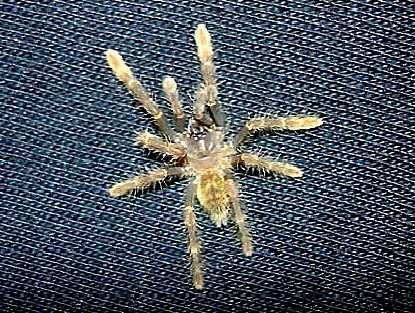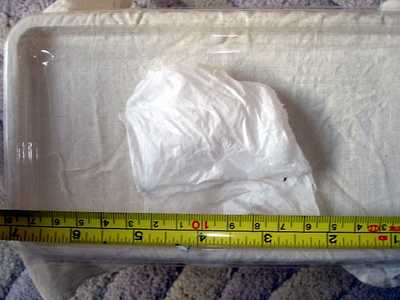Encyocratella
Genus Encyocratella Strand, 1907
By: "Richard C. Gallon (2003) A new African arboreal genus and species of theraphosid spider (Araneae, Theraphosidae, Stromaropelminae) which lacks spermathecae. Bull. Br. arachnol. Soc. 12 (9), 405–411" and "Richard C. Gallon (2005) Encyocratella olivacea Strand, 1907, a senior synonym of Xenodendrophila gabrieli Gallon, 2003 (Araneae: Theraphosidae: Stromatopelminae) with a description of the male. Zootaxa 1003: 45–56".
Genus status. Synonymized: Xenodendrophila Gallon, 2003 (Xenodendrophila gabrieli Gallon, 2003) and also Chaetopelma strandi Schmidt, 1991 by Richard Gallon in 2005.
Type and the only species - Encyocratella olivacea Strand, 1907.
The genus was established in 1907 by Strand on the basis of the sole species of the single female collected from Amani, Tanzania. Afterward R. Raven in 1985, was unable to locate type material, being studying it's congeners, synonymized it with genus Chaetopelma Ausserer, 1871. In 1991 Schmidt proposed the new name - Chaetopelma strandi Schmidt, 1991 to resolve the secondary homonyms, created by Raven's synonymy.
In 2003 R. Gallon has described a new monotypical genus with species Xenodendrophila gabrieli Gallon, 2003 and named it after an other english arachnologist Ray Gabriel who provided study material of the new taxon.
But in 2005 R. Gallon rediscovers the holotype of Encyocratella olivacea Strand, 1907 at the Museum fur Naturkunde der Humboldt-Universitat (Berlin, Germany) and being comparing it with the one of X. gabrieli Gallon have found that both are absolutely identical on taxonomical features. So, the above mentioned synonymy were made and the male of this species has been described for the first time.
Monotypical genus, represented by a single species - the first African and the second tarantula species of the World fauna which lacks spermathecae. The first new findings of this species from the date of description! were made within three specimens - females, which was found in imported in April 1999 batch of Tanzanian theraphosids intended for the pet trade. Two of them died during transit and the third (adult female) maintained in captivity by Ray Gabriel. This time it is some captive-born spiderlings are rarely available.
As a whole the genus (so as the species) differs from other representatives of African tarantula fauna by the absence of spermathecae (sperm storage functions is undertaken by the oviducts and uterus internus). It also differs from the two known African arboreal genera Stromatopelma Karsch, 1881 and Heteroscodra Pocock, 1899 by the reduced leg pilosity and scopulation, and by the absence of large, single, dorsal, black leg markings on the tarsi, metatarsi and tibiae.
Tarsus IV in females of both Heteroscodra spp. and Stromatopelma spp. is proximally divided by a band of stiffened setae; in Encyocratella there is no such proximal division of the scopula on tarsus IV. Female of Encyocratella is further distinguished from that of Heteroscodra spp. by the possession of an unthickened leg IV and by the presence of laterally-opposing femoral scopula on the palp and leg I.
It also differs from all the Harpactirinae Pocock, 1897 genera by the presence of scopulae between the opposing trochanteral and femoral surfaces of the palp and leg I. It further differs from most harpactirine genera by the absence of a retrolateral cheliceral scopula. Encyocratella is distinguished from the Eumenophorinae Pocock, 1897 genera by the absence of robust stridulatory setae on the coxae of the palp and legs I and II. It is readily distinguished from the Selenogyrinae Smith, 1990 genera by the absence of modified stridulatory setae between the chelicerae. The absence of proximal and medial tibial leg spines provides additional distinction from the Old-World ischnocolines.
 Total length, including chelicerae but excluding spinnerets of an adult female of Xenodendrophila gabrieli syn. n. (holotype from type material) 34.1 mm, abdomen - 14 mm in length, 7.5 mm in width, carapace low - 14.4 mm long and 12.2 mm width. Known living captive specimens grows bigger. Fovea deep and ovoid. Ocular tubercle length 2.28, width 2.81. Sternum with three pairs of oval submarginal sigilla. Labium with 10 cuspules. Maxilla with 100 cuspules. Chelicerae with 12 teeth on promargin.
Total length, including chelicerae but excluding spinnerets of an adult female of Xenodendrophila gabrieli syn. n. (holotype from type material) 34.1 mm, abdomen - 14 mm in length, 7.5 mm in width, carapace low - 14.4 mm long and 12.2 mm width. Known living captive specimens grows bigger. Fovea deep and ovoid. Ocular tubercle length 2.28, width 2.81. Sternum with three pairs of oval submarginal sigilla. Labium with 10 cuspules. Maxilla with 100 cuspules. Chelicerae with 12 teeth on promargin.
Prolateral coxal surface of leg I with discrete area of fine, capitate setae (shaped like moss sporophytes) perpendicular to cuticle. Similarly positioned patch of capitate setae on prolateral surface of leg II. Remaining coxal surfaces without such setae. These setae are present in other theraphosid subfamilies and are obvious only when viewed in profile.
Setation: carapace with short uniform pelage not obscuring fovea. Abdomen with short pelage and sparse emergent setae dorsally, becoming denser towards spinnerets. Venter of abdomen without such emergent setae. Sternum, maxillae, coxae and trochanter with uniform covering of short setae without emergent setae. Appendages including dorsum of chelicerae with short pelage of setae and short emergent setae.
Carapace (including ocular tubercle) and dorsum of chelicerae covered with orange-brown setae. Dorsal surface of all legs and palps (including dorsally visible scopulae) similarly coloured except for black femora. Dorsally all tibiae with double row of 3-4 small black flecks. Single row of several small black flecks present dorsally on all metalarsi. No black flecks present on dorsuntof tarsi. Ventral surfaces of sternum, coxae, trochanters and femora of all appendages black/dark brown. Remaining ventrodistal segments of palp and leg I black. Remaining distal segments of legs II-IV charcoal grey with covering of longer orange-brown setae. All tarsal and metalarsal scopulae charcoal grey ventrally. Abdomen dorsally orange-brown with black reticulations confined to anterior and anterior-lateral portions. Remainder of abdomen with black pattern consisting of spots and oblique bars. Venter brown/black, but booklung regions lighter. Spinnerets uniformly charcoal grey.
 In nature found living arboreally beneath peeling tree bark by Joe Beraducci who is the collector of the specimens (pers. comm. with R. Gabriel). Also according the information, published by Vejay S. Kumar (The BTS Journal, May 2004, 19 (3) he was told that later exported specimens collected from crevices on road banks and among tree roots and behind loose bark, "higher up the mountain" where it was cooler in the humid forest regions.
In nature found living arboreally beneath peeling tree bark by Joe Beraducci who is the collector of the specimens (pers. comm. with R. Gabriel). Also according the information, published by Vejay S. Kumar (The BTS Journal, May 2004, 19 (3) he was told that later exported specimens collected from crevices on road banks and among tree roots and behind loose bark, "higher up the mountain" where it was cooler in the humid forest regions.
Keeping. A living captive tarantulas was observed to produce an extensive silken labyrinth retreat when housed in a vivarium furnished with cork bark slabs. No burrowing behaviour was observed in this specimen (R. Gabriel pers. comm. to R. Gallon) which is consistent with an arboreal way of life. Vejay S. Kumar also observes that this species prefers to construct its ‘nest’ on the floor of the enclosure between the bark and the glass sides and does not appear to burrow.
This species can stridulate as the other African tarantulas.
Distribution: Known only from mountains near Arusha and Usambara mountains (Amani), Northern Tanzania.
|
Species |
Common name |
Areal |
Photo |
Biology |
Keeping conditions |
|
olivacea Strand, 1907 |
- |
Tanzania |
Photo Dean Wicker© 2004
Photo Timo Raab© 2005 |
The female body length is approximately 55 mm and leg span 120 mm. |
Must be kept in typical arboreal terrarium with medium level of ventilation. |



